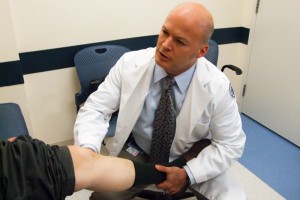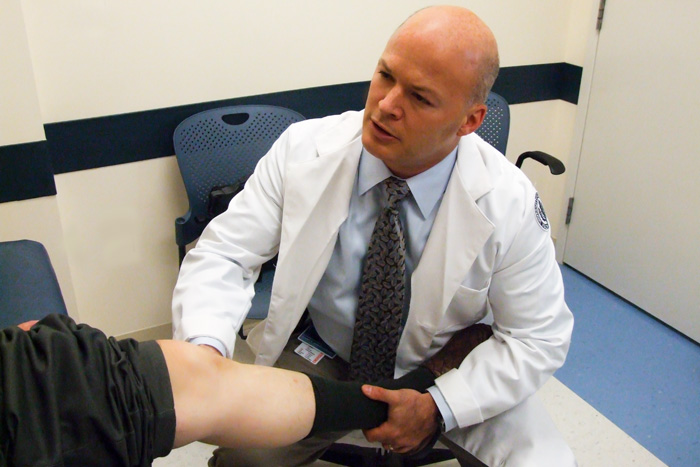
Sports medicine doctors will tell you, when it comes to injuries to knees, hips and shoulders, total joint replacement is a last resort.
“We have so many joints that move so much, and there’s a cost-benefit to that,” says Dr. Thomas DeBerardino, UConn Health Center orthopaedic surgeon and sports medicine physician. “You can move a lot, but you can wear things out.”
The good news is, even when you do wear things out, there are several remedies available to slow the path to a total joint replacement. Add to those options a partial knee replacement, now a same-day surgery at the UConn Health Center.
“We’ve started a program here, due to the advances in technology, where you arrive in the morning and leave at lunch with a partial knee, and you’re walking on your knee, literally,” DeBerardino says. “That’s not to say that it’s without pain, but you get to go home in your own bed, your own couch, prop it up and ice it, and what used to be a huge operation is now much less morbid, much more feasible and very patient friendly.”
By comparison, total knee replacements require larger incisions—and usually one- or two-night hospital stays.
Partial knee replacements have been around for decades, but advances in their design have made it a smaller operation because less bone is removed. The UConn Health Center is the first in the region to offer same-day partial knee replacement, also referred to as unicompartmental knee arthroplasty.
It’s an option for patients who wear out the knee’s medial compartment, toward the inside of the leg, which is more common in men, and those who wear out the lateral compartment, toward the outside of the leg, which women are more prone to do.
As for how long a partial knee replacement lasts, the most current available data indicate patients can expect at least 15 to 20 years. But that’s based on how the procedure used to be done, with larger incisions, more bone removal, and less durable materials. Today it’s a surgery that’s much less prone to complications.
“When you have fewer complications, down in the less-than-1-percent range, things on aggregate last a lot longer,” DeBerardino says. “I would expect that we’re going to get data in the next decade or decade and a half that says over 90 to 95 percent of these are still holding their own and still working fine and there’s no need for revisions or a need to move from a partial knee to a total knee replacement.”
For a consultation with a member of the UConn Sports Medicine Team, call 800-535-6232.
Follow the UConn Health Center on Facebook, Twitter and YouTube.



